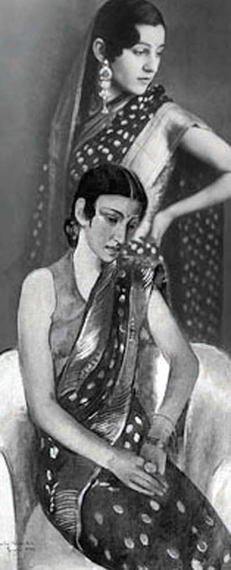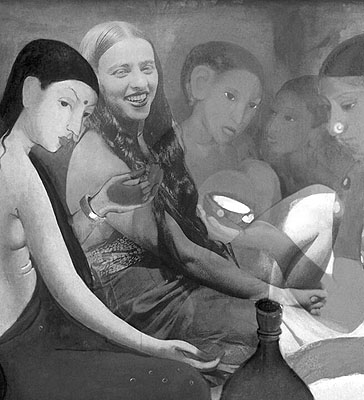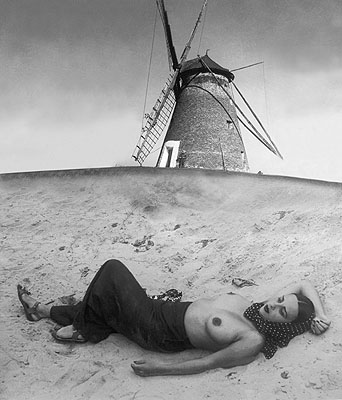
An Indian Artist Family in the 20th Century
Amrita Sher-Gil
Umrao Singh Sher-Gil » Vivan Sundaram »
Exhibition: 3 Oct 2006 – 7 Jan 2007

Haus der Kunst
Prinzregentenstr. 1
80538 München
+49 (0)89-21127113
mail@hausderkunst.de
www.hausderkunst.de
Wed-Mon 10-20, Fri, Thu 10-22

Amrita Sher-Gil : An Indian Artist Family in the 20th Century
"Europe belongs to Picasso, Matisse and Braque and many others. India belongs only to me." Amrita Sher-Gil
The exhibition tells the story of an Indian artist family of three generations by uniting the paintings of Amrita Sher-Gil with the photographs of her father, Umrao Singh Sher-Gil, and the digitally worked photographs of her nephew, Vivan Sundaram. The three positions demonstrate how the perception of identity through self-determination has changed since the late colonial period. The works also serve as convincing examples of the non-concurrent development of modernity and modernism in Europe and India and thus also for the concept of a multiple modern.
Amrita Sher-Gil
Amrita Sher-Gil was born in Budapest in 1913 and grew up in a cosmopolitan family interested in art. Her father, Umrao Singh Sher-Gil, came from an aristocratic family in north India's' Punjab and her mother, Marie Antoinette Gottesmann, was a Hungarian of upper class background. Because of the First World War, the family lived in Budapest until 1921, after which it lived on the estates of the father's side in northern India for eight years.
When the family recognized Amrita's exceptional talent, they made it possible for her to go to Paris for a time, where, at just 16, she started to study at the École des Beaux Arts and soon took part in the Bohemian scene there. From the beginning, nudes, portraits and still lifes were her favored genres. She thus became open to the influence of Realism, foremost that of Paul Gauguin; Surrealism and geometric abstraction, in contrast, left no obvious marks in her work.
Amrita Sher-Gil had her first exhibition in Bombay in 1936 and, since then, her work has become more and more recognized and admired on the Indian subcontinent, too. Her early death in Lahore, however, brought a sudden end to a very promising talent. Not yet 29 years old, Amrita died from a quick and intense disease, whose actual cause has not been revealed to the public.
During her short life, Amrita Sher-Gil tried to "conquer all at once: the alienation cause by her class, her Indo-European ancestry and her gender," according to art historian Geeta Kapur. This alienation, however, also enabled an encounter with India as the experiencing and recognition of the others; this distinguishes Amrita Sher-Gil from Gauguin and the Orientalists, for whom the Orient was primarily an archive of stereotypes and projection planes for their own suppressed desires. The Modernism of Amrita Sher-Gil was based on her completely autonomous understanding of India and her ability to bring together sources of inspiration from both the modern West and historic India.
The decision of the Sher-Gil Family to leave an extensive portion of Amrita's estate to the Indian government became the basis for the foundation of the National Gallery of Modern Art in New Delhi. In Europe Amrita Sher-Gil's works are still largely unknown (exhibitions to date: "Six Indian Painters," Tate Britain, London,1982; "Indian Artists in France," Centre National des Art Plastiques, Paris, 1985; "Amrita Sher-Gil: the Indian Painter and Her French and Hungarian Connections," Ernst Museum, Budapest, 2001). The photographs of Vivan Sundaram were recently exhibited in the Sepia Gallery in New York.
Umrao Singh Sher-Gil
Umrao Singh (1870-1954), an anti-British nationalist, was a reader of philosophy and literature, as well as a talented photographer. He was first given due credit by Stuart Hall and Mark Sealy in their publication "Different" (Phaidon, 2001). In his many self-portraits Umrao Singh presents himself as a pensive Sanskrit scholar or as a practicer of yoga. His self-awareness is nurtured, thus, by a cultural tradition that was destroyed or degraded by colonial politics. He was not a conforming subject, but rather someone, who, using his education and tradition, put up resistance.
Umrao Singh also preserved Amrita Sher-Gil's radiant appearance in hundreds of photographs. Amrita used this posing for the camera as an opportunity to express her self-image, characterized by re-invention and masquerading: at times Indian, at times Hungarian and at times clothed and coiffured in the fashionable Parisian style of the 1930s. The fact that she constantly assumed new roles is not just a sign of playfulness or her ability to adopt different cultural contexts; at least since Vivan Sundaram's montages of these photographs it has become clear that the artist's constant transformation of identity harbors moments of division and crisis.
Vivan Sundaram, Re-take of Amrita
Vivan Sundaram (born 1943) is the grandchild of Umrao Singh and nephew of Amrita Sher-Gil. In 1984 he created a large-format painting "The Sher-Gil Archive," and in 2001/2002 the cycle of digitally processed photographs "Re-take of Amrita." Re-take means to re-shoot a scene. Vivan Sundaram chooses particular moments and guides attention, via specific arrangements, to the hidden expressions in the found images of the family. Under his direction the protagonists give a second performance and go a step farther than was initially intended. The effect that springs from the confrontation of female and male narcissism, the father's intense visual interest in his daughter, as well as the duplication of a figure, is increased here to a perturbing degree. Without expanding on the idea, Amrita herself once spoke of the "hothouse atmosphere" that dominated her family life. In "Re-take of Amrita" it becomes obvious what she may have meant by this.
In addition, Vivan Sundaram charges the spiritual atmosphere, which is characterized by oscillating between cultures, with a kind of pathos. The artificiality of his arrangements remains, however, constantly present for the viewer. In this way, his position enters the works as a contemporary artist, who views this pathos at a distance since the ideas of home and abroad and of residing and traveling have been qualified as opposites for him.
The exhibition catalogue is published by Schirmer/Mosel.
Penguin India published a biography of Amrita Sher-Gil in 2006 and Vivan Sundaram will edit "The Letters and Writings by Amrita" for Tulika Press in New Delhi.
In cooperation with the National Gallery of Modern Art, New Delhi, Ministry of Culture, Government of India, New Delhi, and the Goethe-Institute, New Delhi.�

